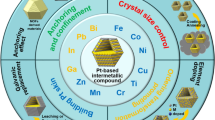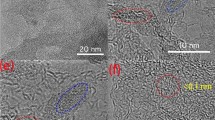Abstract
Highly active and durable electrocatalysts with minimal Pt usage are desired for commercial fuel cell applications. Herein, we present a highly dispersed L10-PtZn intermetallic catalyst for the oxygen reduction reaction (ORR), in which a Zn-rich metal-organic framework (MOF) is used as an in situ generated support to confine the growth of PtZn particles. Despite requiring high-temperature treatment, the intermetallic L10-PtZn particles exhibit a small mean size of 3.95 nm, which confers the catalysts with high electrochemical active surface area (81.9 m2 gPt−1) and atomic utilization. The Pt electron structure and binding strength between Pt and oxygen intermediates are optimized through ligand effect and compressive strain. These advantages result in ORR mass activity and specific activity of 0.926 A mgPt−1 and 1.13 mA cm−2, respectively, which are 5.4 and 4.0 times those of commercial Pt/C. The stable L10 structure provides the catalysts with superb durability; only a halfwave potential loss of 11 mV is observed after 30,000 cycles of accelerated stress tests, through which the structure evolves into a more stable PtZn-Pt core-shell structure. Therefore, the development of a Zn based MOF as a catalyst support is demonstrated, providing a synergy strategy to prepare highly dispersed intermetallic alloys with high activity and durability.

摘要
燃料电池商业化的关键在于实现低铂催化剂的高活性和高 耐久性. 本文通过使用一种富锌MOF作为原位生长的载体来限制 PtZn粒子增长, 成功制备了高分散的L10-PtZn金属间化合物氧还 原反应(ORR)催化剂. 该催化剂经过高温处理后平均粒径仅为 3.95 nm, 具有较高的电化学活性表面积(81.9 m2 gPt−1)和原子利用 率. 配体效应和压缩应变优化了铂的电子结构, 从而调节了铂与氧 中间体之间的结合强度. 催化剂表现出高的质量活性 (0.926 A mgPt−1)和比活性(1.13 mA cm−2), 分别为商业Pt/C催化剂 (0.172 A mgPt−1和0.28 mA cm−2)的5.4倍和4.0倍. 由于L10自身结构 更加稳定, 并且PtZn金属纳米粒子在耐久循环中逐步演变为PtZn-Pt核壳结构, 使得该催化剂在30,000圈加速老化测试中表现出优异 的稳定性(仅11 mV半波电位(E1/2)损耗).
Similar content being viewed by others
References
Wang YJ, Wilkinson DP, Zhang J. Noncarbon support materials for polymer electrolyte membrane fuel cell electrocatalysts. Chem Rev, 2011, 111: 7625–7651
Gasteiger HA, Marković NM. Just a dream—or future reality? Science, 2009, 324: 48–49
Greeley J, Stephens IEL, Bondarenko AS, et al. Alloys of platinum and early transition metals as oxygen reduction electrocatalysts. Nat Chem, 2009, 1: 552–556
Kulkarni A, Siahrostami S, Patel A, et al. Understanding catalytic activity trends in the oxygen reduction reaction. Chem Rev, 2018, 118: 2302–2312
Zhou W, Wu J, Yang H. Highly uniform platinum icosahedra made by hot injection-assisted grails method. Nano Lett, 2013, 13: 2870–2874
Chen C, Kang Y, Huo Z, et al. Highly crystalline multimetallic nanoframes with three-dimensional electrocatalytic surfaces. Science, 2014, 343: 1339–1343
Strasser P, Koh S, Anniyev T, et al. Lattice-strain control of the activity in dealloyed core-shell fuel cell catalysts. Nat Chem, 2010, 2: 454–460
Bu L, Zhang N, Guo S, et al. Biaxially strained PtPb/Pt core/shell nanoplate boosts oxygen reduction catalysis. Science, 2016, 354: 1410–1414
Shao M, Chang Q, Dodelet JP, et al. Recent advances in electrocatalysts for oxygen reduction reaction. Chem Rev, 2016, 116: 3594–3657
Stamenkovic VR, Strmcnik D, Lopes PP, et al. Energy and fuels from electrochemical interfaces. Nat Mater, 2016, 16: 57–69
Stephens IEL, Rossmeisl J, Chorkendorff I. Toward sustainable fuel cells. Science, 2016, 354: 1378–1379
Luo M, Guo S. Strain-controlled electrocatalysis on multimetallic nanomaterials. Nat Rev Mater, 2017, 2: 17059
Stamenkovic VR, Mun BS, Arenz M, et al. Trends in electrocatalysis on extended and nanoscale Pt-bimetallic alloy surfaces. Nat Mater, 2007, 6: 241–247
Hwang SJ, Kim SK, Lee JG, et al. Role of electronic perturbation in stability and activity of pt-based alloy nanocatalysts for oxygen reduction. J Am Chem Soc, 2012, 134: 19508–19511
Ji X, Lee KT, Holden R, et al. Nanocrystalline intermetallics on mesoporous carbon for direct formic acid fuel cell anodes. Nat Chem, 2010, 2: 286–293
Iihama S, Furukawa S, Komatsu T. Efficient catalytic system for chemoselective hydrogenation of halonitrobenzene to haloaniline using PtZn intermetallic compound. ACS Catal, 2015, 6: 742–746
Wang W, Lei B, Guo S. Engineering multimetallic nanocrystals for highly efficient oxygen reduction catalysts. Adv Energy Mater, 2016, 6: 1600236
Furukawa S, Komatsu T. Intermetallic compounds: Promising inorganic materials for well-structured and electronically modified reaction environments for efficient catalysis. ACS Catal, 2017, 7: 735–765
Luo M, Sun Y, Wang L, et al. Tuning multimetallic ordered intermetallic nanocrystals for efficient energy electrocatalysis. Adv Energy Mater, 2017, 7: 1602073
Yang Y, Xiao W, Feng X, et al. Golden palladium zinc ordered intermetallics as oxygen reduction electrocatalysts. ACS Nano, 2019, 13: 5968–5974
Xiao W, Lei W, Gong M, et al. Recent advances of structurally ordered intermetallic nanoparticles for electrocatalysis. ACS Catal, 2018, 8: 3237–3256
Sode A, Li W, Yang Y, et al. Electrochemical formation of a Pt/Zn alloy and its use as a catalyst for oxygen reduction reaction in fuel cells. J Phys Chem B, 2006, 110: 8715–8722
Yan Y, Du JS, Gilroy KD, et al. Intermetallic nanocrystals: Syntheses and catalytic applications. Adv Mater, 2017, 29: 1605997
Liang J, Ma F, Hwang S, et al. Atomic arrangement engineering of metallic nanocrystals for energy-conversion electrocatalysis. Joule, 2019, 3: 956–991
Li Q, Wu L, Wu G, et al. New approach to fully ordered fct-FePt nanoparticles for much enhanced electrocatalysis in acid. Nano Lett, 2015, 15: 2468–2473
Zhao EW, Maligal-Ganesh R, Xiao C, et al. Silica-encapsulated Pt-Sn intermetallic nanoparticles: A robust catalytic platform for parahydrogen-induced polarization of gases and liquids. Angew Chem Int Ed, 2017, 56: 3925–3929
Yang SJ, Antonietti M, Fechler N. Self-assembly of metal phenolic mesocrystals and morphosynthetic transformation toward hierarchically porous carbons. J Am Chem Soc, 2015, 137: 8269–8273
Cui Z, Chen H, Zhao M, et al. High-performance Pd3Pb intermetallic catalyst for electrochemical oxygen reduction. Nano Lett, 2016, 16: 2560–2566
Zhang S, Zhang X, Jiang G, et al. Tuning nanoparticle structure and surface strain for catalysis optimization. J Am Chem Soc, 2014, 136: 7734–7739
Wang H, Xu S, Tsai C, et al. Direct and continuous strain control of catalysts with tunable battery electrode materials. Science, 2016, 354: 1031–1036
Li J, Xi Z, Pan YT, et al. Fe stabilization by intermetallic L10-FePt and Pt catalysis enhancement in L10-FePt/Pt nanoparticles for efficient oxygen reduction reaction in fuel cells. J Am Chem Soc, 2018, 140: 2926–2932
Oezaslan M, Hasché F, Strasser P. Pt-based core-shell catalyst architectures for oxygen fuel cell electrodes. J Phys Chem Lett, 2013, 4: 3273–3291
Jung N, Chung DY, Ryu J, et al. Pt-based nanoarchitecture and catalyst design for fuel cell applications. Nano Today, 2014, 9: 433–456
Ho VTT, Pan CJ, Rick J, et al. Nanostructured Ti0.7Mo0.3O2 support enhances electron transfer to Pt: High-performance catalyst for oxygen reduction reaction J Am Chem Soc, 2011, 133: 11716–11724
Zhang B, Fu G, Li Y, et al. General strategy for synthesis of ordered Pt3M intermetallics with ultrasmall particle size. Angew Chem Int Ed, 2020, 59: 7857–7863
Tian X, Zhao X, Su YQ, et al. Engineering bunched Pt-Ni alloy nanocages for efficient oxygen reduction in practical fuel cells. Science, 2019, 366: 850–856
Wang X, Vara M, Luo M, et al. Pd@Pt core-shell concave decahedra: a class of catalysts for the oxygen reduction reaction with enhanced activity and durability. J Am Chem Soc, 2015, 137: 15036–15042
Zhao X, Chen S, Fang Z, et al. Octahedral Pd@Pt1.8Ni core-shell nanocrystals with ultrathin PtNi alloy shells as active catalysts for oxygen reduction reaction J Am Chem Soc, 2015, 137: 2804–2807
Mazumder V, Chi M, More KL, et al. Core/shell Pd/FePt nanoparticles as an active and durable catalyst for the oxygen reduction reaction. J Am Chem Soc, 2010, 132: 7848–7849
Wang D, Xin HL, Yu Y, et al. Pt-decorated PdCo@Pd/C core-shell nanoparticles with enhanced stability and electrocatalytic activity for the oxygen reduction reaction. J Am Chem Soc, 2010, 132: 17664–17666
Guo S, Zhang S, Su D, et al. Seed-mediated synthesis of core/shell FePtM/FePt (M = Pd, Au) nanowires and their electrocatalysis for oxygen reduction reaction. J Am Chem Soc, 2013, 135: 13879–13884
Acknowledgements
This work was supported by the National Science and Technology Major Project (2017YFB0102900), the National Natural Science Foundation of China (21633008, 21673221 and U1601211), and Jilin Province Science and Technology Development Program (20200201001JC, 20190201270JC and 20180101030JC).
Author information
Authors and Affiliations
Contributions
Ge J supervised the study. Zhao T designed the experiments, performed most of the experiments and characterizations. Luo E, Li Y and Wang X participated in the analyses of the results. Zhao T wrote the manuscript, and Ge J, Liu C and Xing W revised it. All the authors contributed to the general discussion.
Corresponding author
Additional information
Conflict of interest
The authors declare that they have no conflict of interest.
Tuo Zhao is a PhD candidate at the State Key Laboratory of Electroanalytical Chemistry, Changchun Institute of Applied Chemistry (CIAC). He received his BSc degree in materials science and engineering from Hainan University in 2016. His current research interest is the development of efficient ORR catalysts in proton exchange membrane fuel cells.
Junjie Ge is a professor of chemistry at CIAC, Chinese Academy of Sciences (CAS). She received her PhD in physical chemistry from CIAC in 2010 and completed postdoctoral training at the University of South Carolina (2010–2012) and University of Hawaii (2012–2015). She joined CIAC in 2015 as a professor, where she was recruited in the Hundred Talents Program in CAS (2015). Her current research interests focus on hydrogen energy and fuel cells, basic electrochemistry, and electrocatalysis, mainly concentrating in proton exchange membrane-based energy conversion systems.
Electronic supplementary material
Rights and permissions
About this article
Cite this article
Zhao, T., Luo, E., Li, Y. et al. Highly dispersed L10-PtZn intermetallic catalyst for efficient oxygen reduction. Sci. China Mater. 64, 1671–1678 (2021). https://doi.org/10.1007/s40843-020-1582-3
Received:
Accepted:
Published:
Issue Date:
DOI: https://doi.org/10.1007/s40843-020-1582-3




